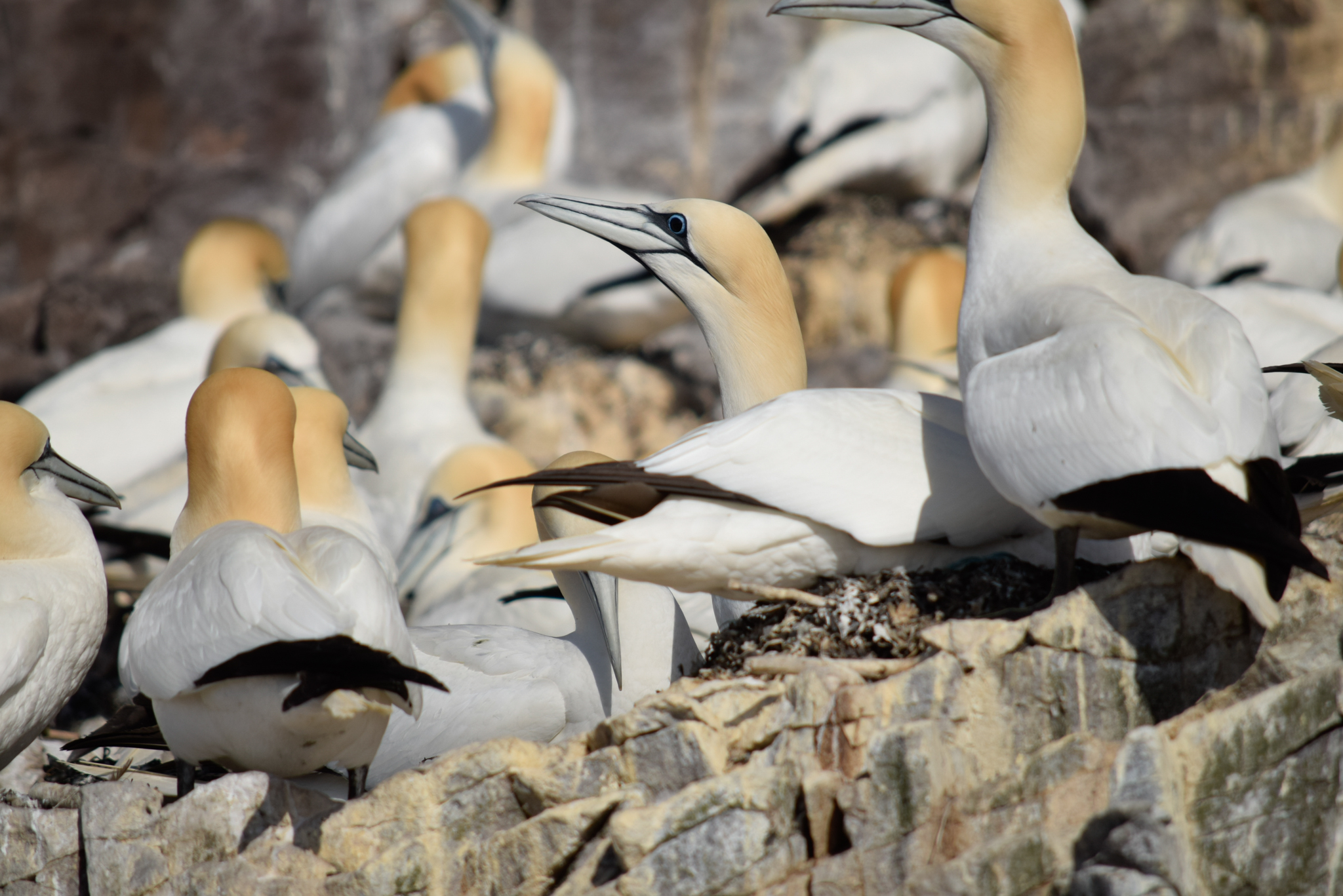 Northern Gannets on Bass Rock off the Scottish coast. The black iris (previously blue) of the pictured gannet indicates the bird has survived an infection from Highly Pathogenic Avian Influenza (HPAI) H5N1; photograph by Patricia Serafini
Northern Gannets on Bass Rock off the Scottish coast. The black iris (previously blue) of the pictured gannet indicates the bird has survived an infection from Highly Pathogenic Avian Influenza (HPAI) H5N1; photograph by Patricia Serafini
In response to continuing and wide-spread outbreaks of H5N1 high pathogenicity avian influenza (HPAI) in wild birds across the globe, the Scientific Task Force on Avian Influenza and Wild Birds (Task Force) has released a statement about HPAI viruses in wild birds and appropriate responses for governments, the poultry sector, wildlife and conservation management, and other stakeholders.
The Task Force, co-convened by the Convention on the Conservation of Migratory Species of Wild Animals (CMS) and the Food and Agriculture Organization of the United Nations (FAO), state that HPAI is causing mass mortalities of wild birds at an unprecedented scale, signalling that HPAI appears to have moved into a new phase in which “this better adapted virus is expected to continue to spread and cause further negative conservation impacts”. Concerningly, breeding colonies on oceanic islands were specifically identified as at risk.
The Statement provides a comprehensive update on the current situation across global regions, and includes guidance on responses to HPAI, incorporating recommendations for countries affected and/ or at risk of HPAI, planning tools and resources for stakeholders including national recommendations and guidance.
Patricia Pereira Serafini is Co-convenor of the Agreement on the Conservation of Albatrosses and Petrels’ Population and Conservation Status Working Group (PaCSWG) and an Environmental Analyst for Brazil’s National Centre for Research and Conservation of Wild Birds. In July 2022 Serafini co-authored a set of guidelines for working with albatrosses and petrels during the outbreak of HPAI which are referenced in the Task Force Statement and are available at the ACAP website under Conservation Guidelines. Commenting on the Task Force’s Statement she said:
“Among the most endangered group of vertebrates in the world are the seabirds of the Order Procellariiformes, which hold albatrosses and petrels. These strictly pelagic birds breed mainly in isolated colonies on oceanic islands, and under natural circumstances are rarely exposed to new pathogens in their breeding grounds. Considering the impact of HPAI on seabird populations seen worldwide and the recent spread of the disease, outbreaks when these amazing birds congregate to breed at colonies are a potential threat to their conservation. All sites where ACAP species assemble may be at risk of exposure via migratory birds or accidental introduction by human activities (e.g. ringers, researchers and tourism) and should thus be in a state of alertness. CMS's statement on H5N1 High pathogenicity avian influenza strengthens the recommendations presented by ACAP in July 2022 regarding guidelines for working with albatrosses and petrels during the ongoing H5N1 avian influenza outbreak.”
At ACAP’s recent Thirteenth Meeting of the Advisory Committee (AC13) in May, at the recommendation of the PaCSWG, the Committee decided on the formation of a group of experts on epidemiology, disease risk assessment and management to advise ACAP on issues related to the ongoing H5N1 avian influenza outbreak. The ACAP´s High Pathogenicity H5N1 Avian Influenza Intersessional Group consists of thirteen experts and is led by Serafini.
“This group is dedicated to compiling the most up-to-date information and revising the ACAP guidelines for working with albatrosses and petrels during the ongoing global outbreak”, said Serafini. “The group will also work to recommend and prioritise ways of effectively communicating the risk to decision-makers and stakeholders within ACAP, and prepare further documents and disease risk assessments, as necessary.”
The full Statement from the Scientific Task Force on Avian Influenza and Wild Birds, “H5N1 High pathogenicity avian influenza in wild birds - Unprecedented conservation impacts and urgent needs” is available here.
Reference:
CMS FAO Co-convened Scientific Task Force on Avian Influenza and Wild Birds (2023). Scientific Task Force on Avian Influenza and Wild Birds statement on H5N1 high pathogenicity avian influenza in wild birds - Unprecedented conservation impacts and urgent needs. Available at: https://www.cms.int/en/publication/h5n1-high-pathogenicity-avian- influenza-wild-birds-unprecedented-conservation-impacts
24 July 2023

 Français
Français  English
English  Español
Español